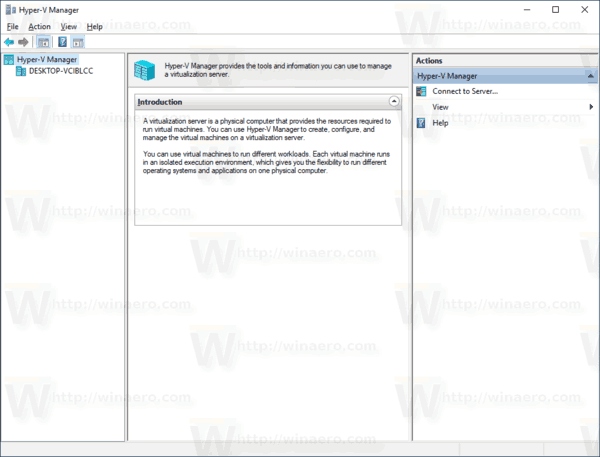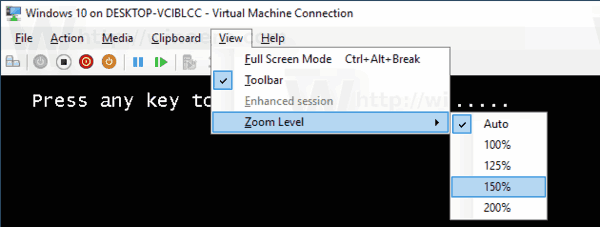Windows 10, Windows 8.1 and Windows 8 come with Client Hyper-V so you can run a supported guest operating system inside a Virtual Machine. Hyper-V is Microsoft's native hypervisor for Windows. It was originally developed for Windows Server 2008 and then ported to Windows client OS. It has improved over time and is present in the latest Windows 10 release as well. Today, we will see how to change the Zoom Level of a virtual machine in Hyper-V and set custom display scaling (DPI) in Windows 10.
Advertisеment
Note: Only Windows 10 Pro, Enterprise, and Education editions include the Hyper-V virtualization technology.
What is Hyper-V

Hyper-V is Microsoft's very own virtualization solution that allows creating virtual machines on x86-64 systems running Windows. Hyper-V was first released alongside Windows Server 2008, and has been available without additional charge since Windows Server 2012 and Windows 8. Windows 8 was the first Windows client operating system to include hardware virtualization support natively. With Windows 8.1, Hyper-V has got a number of enhancements such as Enhanced Session Mode, enabling high fidelity graphics for connections to VMs using the RDP protocol, and USB redirection which is enabled from the host to VMs. Windows 10 brings further enhancements to the native hypervisor offering, including:
- Hot add and remove for memory and network adapters.
- Windows PowerShell Direct – the ability to run commands inside a virtual machine from the host operating system.
- Linux secure boot - Ubuntu 14.04 and later, and SUSE Linux Enterprise Server 12 OS offerings running on generation 2 virtual machines are now able to boot with the secure boot option enabled.
- Hyper-V Manager Down-level management - Hyper-V manager can manage computers running Hyper-V on Windows Server 2012, Windows Server 2012 R2 and Windows 8.1.
To be able to override default display scaling (DPI) for a Virtual Machine, you need to disable its Enhanced Session feature. For more details, please refer to the article
Enable or Disable Hyper-V Enhanced Session in Windows 10
Otherwise, the display of your virtual machine will be configured automatically.
To change DPI of a Hyper-V virtual machine, do the following.
- Turn off your virtual machine if it is running.
- Disable the Hyper-V Enhanced Session feature for this machine.
- Start your VM.
- Click on View in the menu bar, select the Zoom Level item, then select 100%, 125%, 150%, or 200% for the display scaling you want for the virtual machine.

That's it.
Support us
Winaero greatly relies on your support. You can help the site keep bringing you interesting and useful content and software by using these options:

Step 2: Disable the Hyper-V Enhanced Session feature for this machine.
This is a bit Delphic. It implies you can disable Enhanced Session mode for the VM. You can’t. It may be worth expanding on the point to make it clear that “machine” here means the host, not the guest.